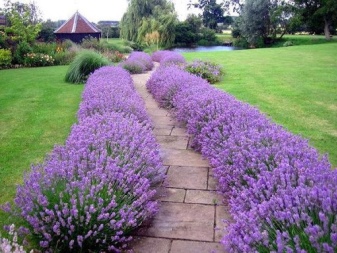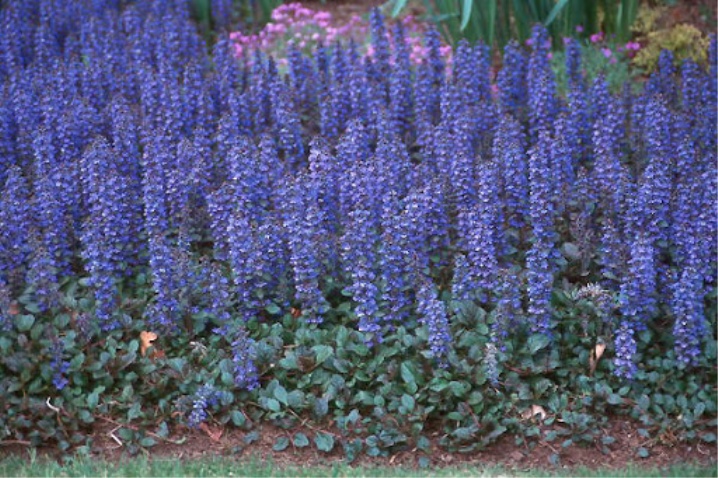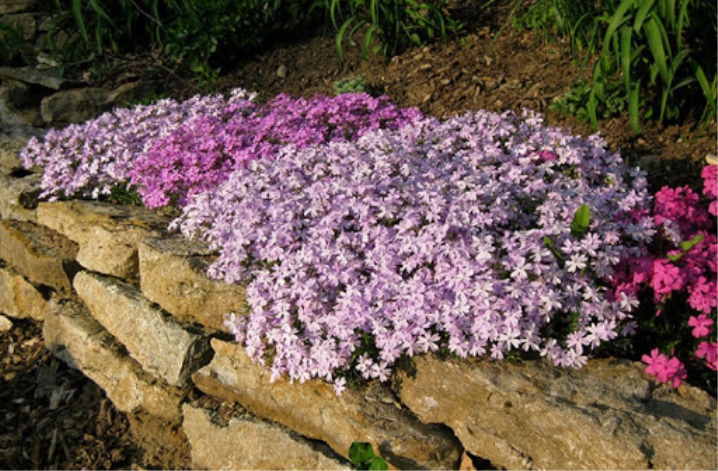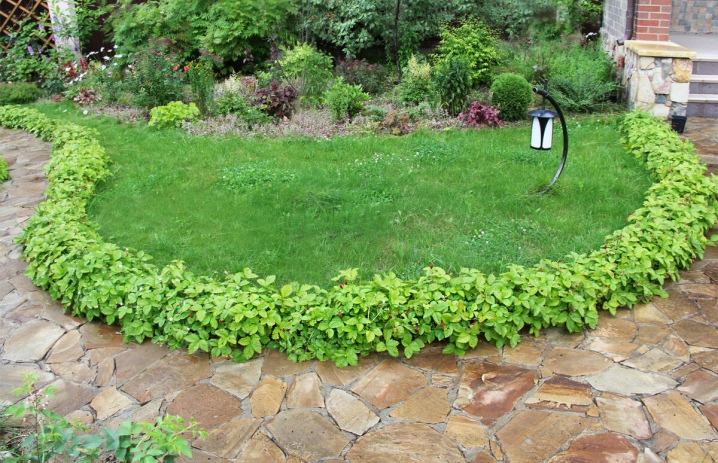Overview of dwarf curb perennials

Flowers in a person's life play an important role, since with their help we not only express our feelings, but also decorate the space. You can revive and decorate a room with flowers, but you can give free rein to all your talents and desires only on a plot of land. In this article, we take a look at the best low perennial plantings for curbs.
Peculiarities
Low-growing perennial plants have a number of advantages, including their unpretentiousness and life for more than 2 years. With the onset of cold weather, the most beautiful and greenest part of the plant dies, and the rhizome goes into a state of dormancy. With the arrival of spring, the roots awaken, and new shoots grow again and delight us with their flowering.
With the help of low-growing curb plants, you can emphasize the shape of the flower bed, beautifully edging the lawn, framing the path in the country or highlighting the necessary area.

Plant varieties
Hosta
Hosta is a perennial plant that has beautiful leaves with different colors depending on the variety. It can be undersized or dwarf. In July-August, flowering begins, inflorescences of pale white or lilac appear, towering above the bush. The flowers are like small lilies with a delicate scent.
A plant native to Asia, it prefers partial shade and a humid climate. It is unpretentious in care, grows rather slowly, multiplies well and is used as border or independent plantings. Perfectly harmonizes with other colors, gives them a fabulous green flavor.

Pinnate carnation
Pinnate carnation - a perennial plant, reaching a height of only 30 cm. It has erect stems, and the inflorescences are collected in umbrellas. The homeland of the flower is Eastern Europe, Central and Southern Russia. In the first year of growth, only shoots are formed, but already in the second year, abundant flowering appears, which begins in June and lasts about a month.
The plant is quite unpretentious, perfectly reproduces by seeds, layering and dividing the bush. Prefers to grow in sunny areas, loves regular and moderate watering, as well as periodic feeding.
Depending on the variety, flowering can be white, pink and lilac.

Sedum prominent
This plant belongs to the genus Fatty. Is a succulent, which is distinguished by its unpretentiousness and the ability to grow in arid places and mountains. Sedum is very popular, as it has luxurious inflorescences with a diameter of more than 10 cm. The plant grows gently on the soil surface, thus forming a continuous decorative carpet. Flowering can be of different colors: pink, lilac, etc..
In addition to beautiful flowers, sedum is attractive for its leaves. They are very juicy and fleshy, fit snugly to the stem, and range in color from dark green to dark burgundy. Flowering begins in early July and lasts until late autumn. The plant is not afraid of the first frosts, therefore it decorates the borders longer than its counterparts. Propagated by cuttings. Combines perfectly with other garden flowers.

Heuchera small-flowered
Heuchera is an excellent low-growing curb plant that has gorgeous curly leaves from green to dark purple. During growth, it reaches a height of 45 cm. Flowering begins in mid-summer. Inflorescences are small cream or pink flowers.The flower loves partial shade or diffused sun.
For a beautiful bush formation, it must be periodically cut off. This is usually done in the spring before the onset of the growing season. Despite the fact that the plant is perennial, it can freeze in severe frosts.
To avoid this, it is recommended to transplant it into a pot for the winter and put it in a warmer place.
Propagated by seeds and dividing the bush.

Narcissus
Narcissus Is a bulbous plant that begins to bloom in spring, late April or early May. Flowering starts before the leaves open. The plant is ideal for framing borders. Some species reach a height of 20-40 cm. The daffodil flower itself consists of 6 petals and a perianth. There are various varieties that differ in the structure of the flower. It can be double and simple, as well as with a different shape of the crown.
Narcissus does not like direct rays of the sun, as the inflorescence can burn out. Mostly grows out of the blue or on a small hill, where there will be no melt water and excess moisture. It is absolutely unpretentious to the soil, but prefers loam most of all. The flower is planted in a permanent place in the first half of September, propagating by dividing the bulb. It tolerates winter frosts well without special shelter.


Lavender
This plant is evergreen, has a kind of root that can go into the soil up to 2 meters. Its flowers are spike-shaped inflorescences of lilac or blue. Flowering occurs in mid-summer. Lavender is considered a honey plant with a wonderful scent. Propagated by seeds and dividing the bush. For long and abundant flowering, it is better to pick off the first flowers.
Weeds also need to be removed because they clog young bushes. Periodically, it is necessary to fertilize with potash fertilizers. Systematic watering, especially on hot days, significantly improves the growth and brightness of the flower. Regular stagnation of water in the soil can lead to diseases that cannot be treated.


Heather
Heather is widespread among gardeners and is used for planting along paths and creating curbs. It is a small shrub with a height of 30 to 50 cm, characterized by creeping stems with strong branching. The leaf plates are rolled into tubes, and the purple flowers look like small bells.
Flowering usually begins in July, but the flowers acquire the brightest and most intense shade after the onset of the first frost. At this time, the leaves turn burgundy or yellow. Propagated by seed. Loves regular watering, and in the spring - the obligatory pruning.
Loosening of the soil is essential as it removes weeds and improves air access to the roots.


Erika
Blooming Erica will not leave a single amateur gardener indifferent. This heather plant is evergreen. It is undersized, reaches a height of about 20 cm. In appearance, Eric is somewhat reminiscent of heather, but differs from it in more lush and bright flowering. Depending on the species, flowering begins in spring and ends in autumn. The plant can live in one place for 15 to 20 years.


Bloodroot
Cinquefoil is a shrub with erect or creeping shoots. The leaves are feathery or multipart, gray or green. Flowering begins in May-September. Inflorescences are single panicles of various colors. Depending on the species, there may be fruits. Cinquefoil is not demanding on growing conditions. Prefers lighted areas with little shade. It grows on loose, fertilized soil with good drainage. Propagated mainly by seeds.
Watering is necessary only in case of prolonged drought, approximately once a week. For long-lasting and lush flowering, it is recommended to spray the bush with water in the evening. Pruning is a must in early spring and fall.Without it, the bush will lose its shape and look sloppy. Rejuvenating pruning should be done every 5 years. For this, a third of the branches are cut for 3 years in a row. This procedure will completely rejuvenate the shrub.
The plant is not susceptible to various diseases and pests.

Japanese spirea
Japanese spiraea is distinguished by summer flowering, is perfect for curly haircuts and has a wide range of uses. With its help, they form curbs, create hedges, it is perfect for group and single plantings. The plant tolerates harsh winters and hot days..
In order for it to bloom all summer, it must be provided with a sufficiently lit place. The quality of the soil does not matter, as the plant is picky. Spirea prefers moderate watering, which can be increased in the heat. Four-year-old bushes must be cut to the ground. Propagated by dividing the bush or layering.

Avens
The pride of the garden for some gardeners is the gravilat. This is a perennial plant, the height of the bush reaches 60 cm. Its leaves are attached with short petioles and collected in a basal rosette. The shrub has simple, double or semi-double flowers of red or orange color with a diameter of 3-4 cm.
The flowering time depends on the type of shrub. Basically, it lasts from May to July or from August to October. The plant is light-loving enough, but it can grow in a little shade. Loves moderate watering, in heat and drought it doubles. The flower does not tolerate transplanting well enough, so you need to change the place of growth no more often than once every 4 years. This treatment stimulates profuse flowering and growth. The flower tolerates frost well, does not require special shelter.

Tenacious
The creeping insect is a ground cover plant that prefers moisture. It forms dense bushes and cushions 20 centimeters high. The tenacious is attractive due to the leaves, which, depending on the variety, have a different shade: burgundy, purple, yellow-orange. The inflorescence is in the form of a spikelet of small flowers, as a rule, of a light blue hue. Propagated by seed. The soil around the shrub should not dry out.
The tenacious herb grows rapidly, so it is necessary to control its distribution. For a beautiful look, you should pick off the inflorescences in time.

Dahlias
Dahlias can be a chic framing for borders. The plant is long-flowering, with a varied palette of shades. Flowering begins in mid-summer and lasts until the very frost. Despite the fact that it is quite easy to grow dahlias, they still need some care.
In the fall, it is recommended to dig up the tubers and provide them with comfortable storage in winter. In the spring they are planted in the ground. The place of growth should be chosen in the sun, without draft and wind. The land must be drained and fertilized.

Phlox
The main advantage of phlox is their decorative flowering... The flower is a ball of small, simple flowers. Phlox propagates by cuttings or seeds. It grows quickly and exudes a delicate aroma. Ideal for planting in flower beds or framing curbs. With proper care in the same place, it can grow for decades.

Other
Elegance and simplicity chamomile made it popular among gardeners and florists. A plant from the Aster family is widespread in the countries of South Africa and the Mediterranean. Its flower looks like a small sun with a yellow center and white thin petals. Chamomile blooms from June to September.
Needs a transplant every 5 years. The optimum temperature for growth is 19-20 ° C. Likes regular watering, but without excess moisture. Reproduction takes place by seeds and dividing the bush. Depending on the variety, the flower can be double and simple, as well as have different shades.

Bushes asters reach heights up to 30 cm. The palette of inflorescence shades is varied.It can be pink, purple and other bright and muted tones. The plant prefers to grow in fertile and well-drained soils. Aster is quite unpretentious in leaving. We need regular watering, soil fertilization and pruning. For a beautiful shape, the shrub should pinch the main stem. Asters do not tolerate stagnant water and shade.

Selection Tips
If you decide to decorate your border and plant low-growing perennial plants, then to choose a certain type of flower it is better to draw up a plan of the flower bed, marking the intended flowers on it with multi-colored pencils: how do you imagine the arrangement, what tone will be in the foreground, how the flower garden will look like. When choosing flowers, it is better to choose those plants that are neutral to rainy and sunny weather.
The border of low-growing flowers should not cover the whole picture of the flower garden, so their height should not exceed 25-30 cm.

When planting plants, consider their width and height as they grow. Allocate enough space for the flower, but exclude possible large gaps. It is better to plant the same type of plants in two rows. It is very important that the curb does not disintegrate and has its own shape. To do this, you need to choose compact plants with slow growth.
The color of the composition should be in harmony with other plantings in the flower bed. For a long-lasting, spectacular look, it is better to plant long-flowering plants of the same color and type. Thanks to this, it will be possible to achieve the same hedge height, as well as uniform flowering. This is the only way you will achieve a beautiful edging of the border and a clear picture.
Winter-hardy species are considered the strongest, but they differ in decorative leaves, not flowers.

Care rules
Despite the fact that it is quite easy to care for perennials, you should still adhere to some rules:
- remove weeds in time and loosen the root soil;
- choose the right place for planting (shaded or sunny), the splendor of flowering and growth depend on it;
- flowers require regular fertilizing, especially if they grow on poor soils;
- if there is an empty space in the curb, and it looks ugly, you need to plant young seedlings in time to give density and shape;
- plants that are especially sensitive to frost, not intended for the northern regions, need shelter for the winter;
- fast growing species need to be constantly trimmed and controlled.
For an overview of low-growing border perennial plants, see the video.



































































The comment was sent successfully.